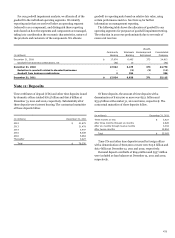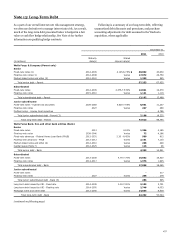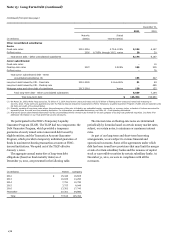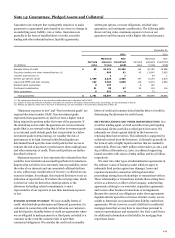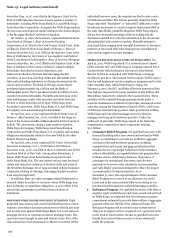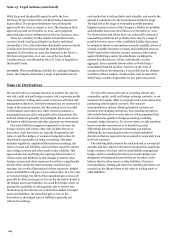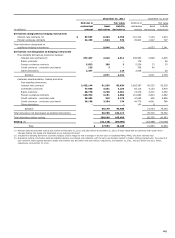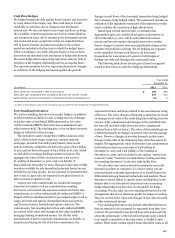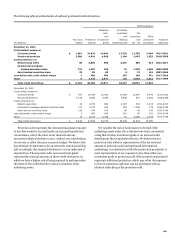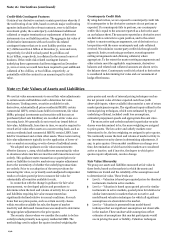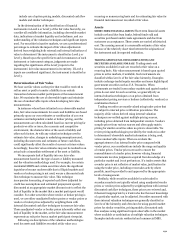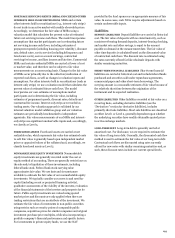Wells Fargo 2011 Annual Report Download - page 186
Download and view the complete annual report
Please find page 186 of the 2011 Wells Fargo annual report below. You can navigate through the pages in the report by either clicking on the pages listed below, or by using the keyword search tool below to find specific information within the annual report.
Note 15: Legal Actions (continued)
Wells Fargo and the plaintiffs agreed to settle the In re
Wachovia Preferred Securities and Bond/Notes Litigation for
$590 million. The proposed settlement was preliminarily
approved by the Court on August 9, 2011. The hearing on final
approval was held on November 14, 2011, and a judgment
approving class action settlements was filed on January 3, 2012.
There are a number of other similar actions filed in state
courts in North Carolina and South Carolina by individual
shareholders. Two of the individual shareholder actions in South
Carolina have been dismissed and the shareholders have
appealed. On December 22, 2011, the dismissal of the Rivers v.
Wachovia Corporation, et al. case, one of the two South
Carolina actions, was affirmed by the U.S. Court of Appeals for
the Fourth Circuit.
OUTLOOK
When establishing a liability for contingent litigation
losses, the Company determines a range of potential losses for
each matter that is both probable and estimable, and records the
amount it considers to be the best estimate within the range.
The high end of the range of reasonably possible potential
litigation losses in excess of the Company’s liability for probable
and estimable losses was $1.2 billion as of December 31, 2011.
For these matters and others where an unfavorable outcome is
reasonably possible but not probable, there may be a range of
possible losses in excess of the established liability that cannot
be estimated. Based on information currently available, advice of
counsel, available insurance coverage and established reserves,
Wells Fargo believes that the eventual outcome of the actions
against Wells Fargo and/or its subsidiaries, including the
matters described above, will not, individually or in the
aggregate, have a material adverse effect on Wells Fargo’s
consolidated financial position. However, in the event of
unexpected future developments, it is possible that the ultimate
resolution of those matters, if unfavorable, may be material to
Wells Fargo’s results of operations for any particular period.
Note 16: Derivatives
We use derivatives to manage exposure to market risk, interest
rate risk, credit risk and foreign currency risk, to generate profits
from proprietary trading and to assist customers with their risk
management objectives. Derivative transactions are measured in
terms of the notional amount, but this amount is not recorded
on the balance sheet and is not, when viewed in isolation, a
meaningful measure of the risk profile of the instruments. The
notional amount is generally not exchanged, but is used only as
the basis on which interest and other payments are determined.
Our asset/liability management approach to interest rate,
foreign currency and certain other risks includes the use of
derivatives. Such derivatives are typically designated as fair
value or cash flow hedges, or economic hedge derivatives for
those that do not qualify for hedge accounting. This helps
minimize significant, unplanned fluctuations in earnings, fair
values of assets and liabilities, and cash flows caused by interest
rate, foreign currency and other market value volatility. This
approach involves modifying the repricing characteristics of
certain assets and liabilities so that changes in interest rates,
foreign currency and other exposures do not have a significantly
adverse effect on the net interest margin, cash flows and
earnings. As a result of fluctuations in these exposures, hedged
assets and liabilities will gain or lose market value. In a fair value
or economic hedge, the effect of this unrealized gain or loss will
generally be offset by the gain or loss on the derivatives linked to
the hedged assets and liabilities. In a cash flow hedge, where we
manage the variability of cash payments due to interest rate
fluctuations by the effective use of derivatives linked to hedged
assets and liabilities, the unrealized gain or loss on the
derivatives or the hedged asset or liability is generally not
reflected in earnings.
We also offer various derivatives, including interest rate,
commodity, equity, credit and foreign exchange contracts, to our
customers but usually offset our exposure from such contracts by
purchasing other financial contracts. The customer
accommodations and any offsetting financial contracts are
treated as free-standing derivatives. Free-standing derivatives
also include derivatives we enter into for risk management that
do not otherwise qualify for hedge accounting, including
economic hedge derivatives. To a lesser extent, we take positions
based on market expectations or to benefit from price
differentials between financial instruments and markets.
Additionally, free-standing derivatives include embedded
derivatives that are required to be accounted for separately from
their host contracts.
The following table presents the total notional or contractual
amounts and fair values for derivatives designated as qualifying
hedge contracts, which are used as asset/liability management
hedges, and free-standing derivatives (economic hedges) not
designated as hedging instruments that are recorded on the
balance sheet in other assets or other liabilities. Customer
accommodation, trading and other free-standing derivatives are
recorded on the balance sheet at fair value in trading assets or
other liabilities.
184



